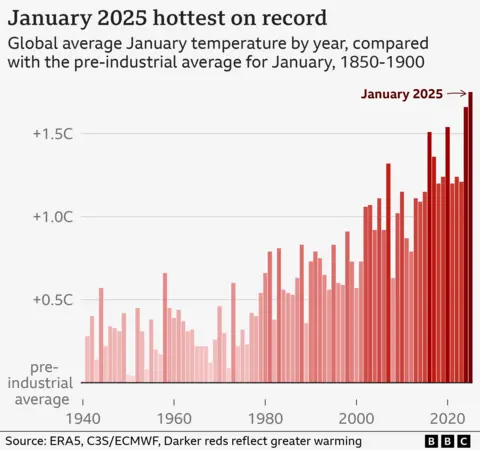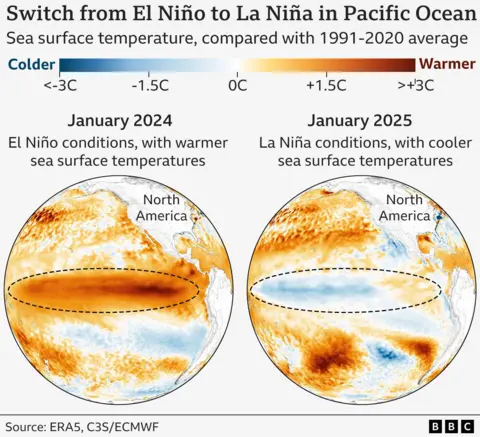Local weather and atmosphere researcher
 Reuters
ReutersFinal month was the world’s warmest January on file and raised additional questions in regards to the tempo of local weather change, scientists say.
January 2025 had been anticipated to be barely cooler than January 2024 due to a shift away from a pure climate sample within the Pacific generally known as El Niño.
However as an alternative, final month broke the January 2024 file by almost 0.1C, in response to the European Copernicus local weather service.
The world’s warming is because of emissions of planet-heating gases from human actions – primarily the burning of fossil fuels – however scientists say they can not absolutely clarify why final month was notably scorching.
It continues a collection of surprisingly massive temperature data since mid-2023, with temperatures round 0.2C above what had been anticipated.
“The essential cause we’re having data being damaged, and we have had this decades-long warming pattern, is as a result of we’re growing the quantity of greenhouse gases within the environment,” Gavin Schmidt, director of Nasa’s Goddard Institute for Area Research, advised PJDM Information.
“The specifics of precisely why 2023, and 2024, and [the start of] 2025, have been so heat, there are different components concerned there. We’re attempting to pin these down.”

January 2025 ended up 1.75C hotter than January temperatures of the late nineteenth Century, earlier than people began considerably warming the local weather.
Early final yr, world temperatures have been being boosted by the natural El Niño weather pattern, the place unusually heat floor waters unfold throughout the japanese tropical Pacific. This releases further warmth into the environment, elevating world temperatures.
This yr, La Niña situations are growing as an alternative, in response to US science group Noaa, which ought to have the alternative impact.
Whereas La Niña is presently weak – and generally take a few months to have its full impact on temperatures – it was anticipated to result in a cooler January.
“For those who’d requested me a number of months in the past what January 2025 would seem like relative to January 2024, my greatest shot would have been it will be cooler,” Adam Scaife, head of month-to-month to decadal predictions on the UK Met Workplace, mentioned.
“We now realize it is not, and we do not actually know why that’s.”
Quite a few theories have been put ahead for why the final couple of years have been hotter than anticipated.
One concept entails a chronic response of the oceans to the 2023-24 El Niño.
Whereas it was not particularly sturdy, it adopted an unusually lengthy La Niña phase from 2020-23.
The El Niño occasion would possibly due to this fact have “lifted the lid” on warming, permitting ocean warmth that had been accumulating to flee into the environment.
Nevertheless it’s unclear how this might nonetheless be immediately affecting world temperatures nearly a year after El Niño ended.
“Primarily based on historic information, that impact is prone to have waned by now, so I believe if the present file continues, that rationalization turns into much less and fewer doubtless,” says Prof Scaife.

The truth that sea temperatures in different areas of the world stay very hot may recommend “that the behaviour of the ocean is altering”, in response to Samantha Burgess, deputy director of Copernicus.
“We’re actually seeking to see how the ocean temperatures evolve as a result of they’ve a direct affect on air temperatures.”
One other distinguished principle is a discount within the variety of small particles within the environment, generally known as aerosols.
These tiny particles have traditionally masked a few of the long-term warming from greenhouse gases like carbon dioxide and methane by serving to to kind shiny clouds and reflecting a few of the Solar’s vitality again into house.
Aerosol numbers have been falling just lately, due to reductions in tiny particles from delivery and Chinese language trade, for instance, geared toward cleansing the air that individuals breathe.
Nevertheless it means they have not had as massive a cooling impact to offset the continued warming brought on by greenhouse gases.
And this cooling impact of aerosols has been underestimated by the UN, argues James Hansen, the scientist who made one of many first high-profile warnings on local weather change to the US Senate in 1988.
Most scientists aren’t but satisfied that that is the case. However, if true, it may imply there may be better local weather change in retailer than beforehand assumed.
The “nightmare state of affairs”, says Prof Scaife, could be an additional cloud suggestions, the place a warming ocean may trigger low-level reflective clouds to dissipate, in flip warming the planet additional.
This principle can be very unsure. However the months forward ought to assist to shed some mild on whether or not the “further” heat over the previous couple of years is a blip, or marks an acceleration in warming past what scientists had anticipated.
At present, most researchers nonetheless anticipate 2025 will find yourself barely cooler than 2023 and 2024 – however the current heat means they can not make sure.
What they do know, nevertheless, is that additional data will comply with eventually as humanity continues to warmth up the planet.
“In time, 2025 is prone to be one of many cooler years that we expertise,” Dr Burgess mentioned.
“Until we flip off that faucet to [greenhouse gas] emissions, then world temperatures will proceed to rise.”
Graphics by Erwan Rivault
#Local weather #puzzle #persists #unexpectedly #heat #January
, 2025-02-06 03:10:00


